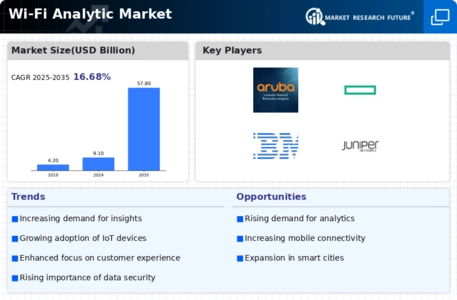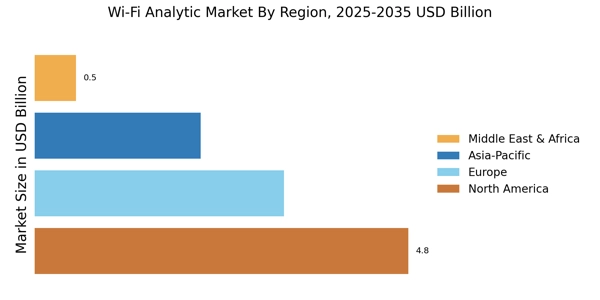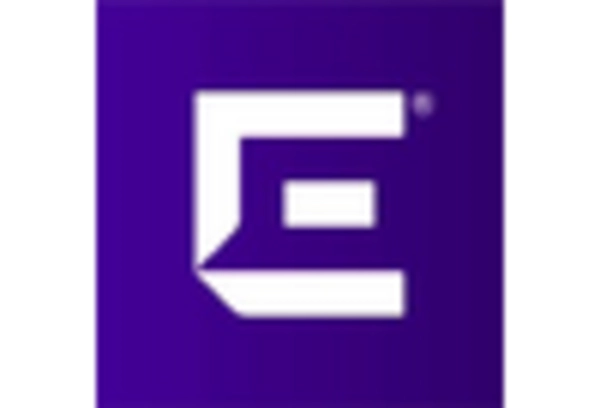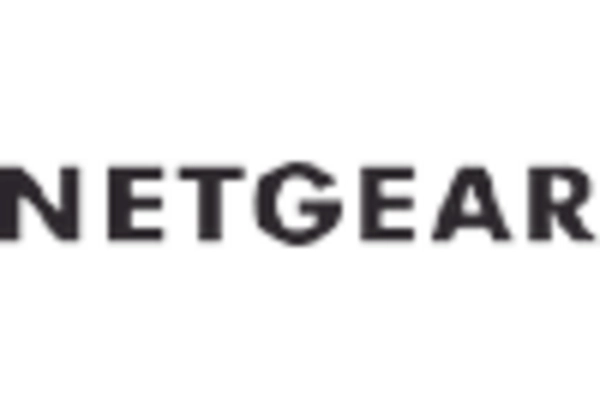Growing Demand for Data-Driven Insights
The Wi-Fi Analytic Market is experiencing a surge in demand for data-driven insights as businesses increasingly recognize the value of customer behavior analytics. Organizations are leveraging Wi-Fi analytics to gather data on foot traffic, dwell time, and customer demographics. This trend is particularly pronounced in retail environments, where data indicates that 70% of retailers are utilizing analytics to enhance customer experiences. By understanding customer patterns, businesses can optimize store layouts and marketing strategies, leading to improved sales and customer satisfaction. The ability to make informed decisions based on real-time data is propelling the growth of the Wi-Fi Analytic Market, as companies seek to gain a competitive edge in their respective sectors.
Enhanced Customer Experience Initiatives
In the Wi-Fi Analytic Market, enhancing customer experience has become a pivotal driver. Businesses are increasingly investing in Wi-Fi analytics to create personalized experiences for their customers. For instance, by analyzing customer behavior, companies can tailor promotions and services to meet specific needs. Data suggests that 80% of consumers are more likely to make a purchase when offered personalized experiences. This trend is particularly evident in hospitality and retail sectors, where customer satisfaction directly correlates with revenue. As organizations strive to foster loyalty and repeat business, the integration of Wi-Fi analytics into customer experience strategies is likely to continue to expand, further solidifying its role in the Wi-Fi Analytic Market.
Rise of Smart Cities and IoT Integration
The emergence of smart cities is significantly influencing the Wi-Fi Analytic Market. As urban areas increasingly adopt Internet of Things (IoT) technologies, the demand for robust Wi-Fi analytics solutions is on the rise. Smart city initiatives often rely on data collected from public Wi-Fi networks to monitor traffic patterns, public safety, and resource allocation. Reports indicate that cities implementing smart technologies can reduce operational costs by up to 30%. Consequently, municipalities are investing in Wi-Fi analytics to enhance urban planning and improve citizen engagement. This trend not only drives the growth of the Wi-Fi Analytic Market but also fosters innovation in urban infrastructure and services.
Increased Focus on Security and Compliance
Security and compliance concerns are becoming paramount in the Wi-Fi Analytic Market. As data privacy regulations tighten, organizations are compelled to adopt analytics solutions that ensure compliance with legal standards. The implementation of Wi-Fi analytics allows businesses to monitor network security and user behavior, thereby identifying potential threats. Data indicates that 60% of companies view compliance as a critical factor in their technology investments. By prioritizing security and compliance, organizations can mitigate risks associated with data breaches and enhance customer trust. This focus on security is likely to drive further investment in the Wi-Fi Analytic Market, as businesses seek to protect sensitive information while leveraging analytics for growth.
Expansion of E-commerce and Omnichannel Strategies
The expansion of e-commerce and omnichannel strategies is a key driver in the Wi-Fi Analytic Market. As consumers increasingly engage with brands across multiple channels, businesses are utilizing Wi-Fi analytics to bridge the gap between online and offline experiences. Data shows that 75% of consumers expect a seamless experience when interacting with brands, regardless of the channel. By analyzing customer interactions through Wi-Fi networks, companies can gain insights into shopping behaviors and preferences, enabling them to create cohesive marketing strategies. This trend is particularly relevant as retailers adapt to changing consumer expectations, making the Wi-Fi Analytic Market an essential component of modern business strategies.


















Leave a Comment